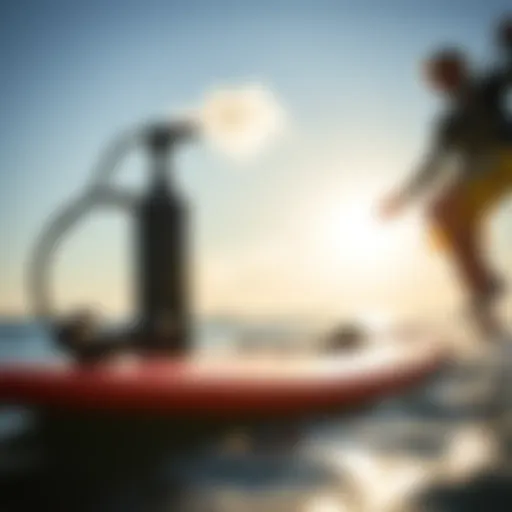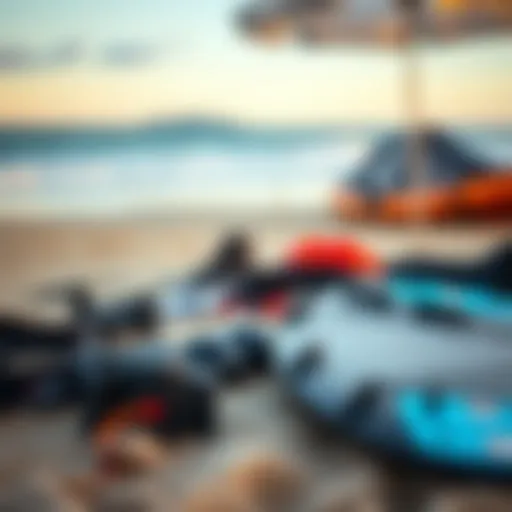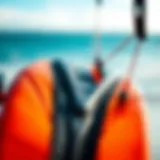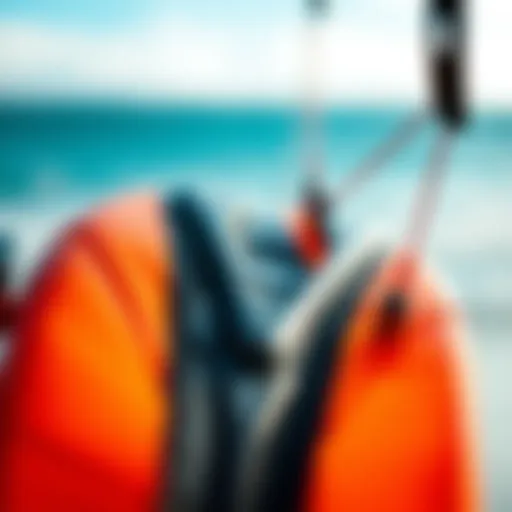Exploring the Armstrong Foil Package in Kiteboarding


Intro
Kiteboarding has come a long way, and the advent of technology in this thrilling sport is nothing short of fascinating. At the forefront of innovative kiteboarding gear is the Armstrong foil package. This piece of equipment has not only redefined what riders can achieve on the water but has also become a subject of interest for both seasoned enthusiasts and newcomers alike.
In this article, we delve into the intricacies of the Armstrong foil package. From its distinct design to the cutting-edge materials used, and the overall impact on performance, there's a lot to unpack. The aim is to shed light on how this gear can elevate the riding experience and help riders of all levels gain a better understanding of its potential benefits.
Through thorough analysis and practical tips, we intend to provide a roadmap for kiteboarders eager to expand their skills and fully leverage the capabilities of the Armstrong foil package.
Gear Insights
Latest Gear Reviews
When it comes to kiteboarding, having the right gear can make all the difference. The Armstrong foil package stands out due to its seamless blend of functionality and performance. Let’s look into some key details:
- Construction Quality: The materials used in the Armstrong foil package are designed to withstand a variety of conditions while reducing drag. This results in a smoother ride.
- Design Features: The hydrodynamic shapes of these foils allow for better maneuverability and quicker response times, making them ideal for both racing and freestyle maneuvers.
- User Feedback: Riders have noted the ease of setup and adjustment which makes this package a favorite among both beginners and experienced riders. Being able to adapt quickly is invaluable when conditions change.
Essential Gear for Beginners
For those just getting their feet wet in the world of kiteboarding, starting with the right gear is essential. Here are some fundamental components every beginner should consider:
- Foil Package: Investing in a reliable foil package like Armstrong can set a solid foundation for learning.
- Kite Size: Choosing an appropriate kite size based on your weight and wind conditions can dramatically improve your early experiences.
- Safety Equipment: A proper harness designed for foil riding, along with a helmet and impact vest, are crucial for a safe adventure on the water.
The Armstrong foil package complements these essentials, ensuring new riders experience progress rather than frustration.
Techniques and Tips
Advanced Tricks and Techniques
Once you've got the basics down, it’s time to explore advanced maneuvers. The responsive nature of the Armstrong foil allows for a variety of tricks:
- Jumps: With the right wind conditions, riders often report that using the Armstrong foil gives them more lift and hang-time.
- Transitions: Smooth transitions can significantly enhance your performance, and mastering the art of turning swiftly can be done more effectively with a well-designed foil package.
Safety Practices for Kiteboarders
As with any exhilarating sport, safety cannot be overlooked. Here are some important practices:
- Pre-ride checks: Always inspect your gear for any wear and tear, ensuring your foil and kite are in good condition.
- Awareness of surroundings: Understanding the water conditions and being mindful of other riders is key to avoiding accidents.
- Emergency protocols: Knowing how to handle an emergency, whether it’s releasing the kite or safely swimming back to shore, is essential.
"The difference between a fun day on the water and a disaster often comes down to preparation and respect for the conditions."
In the long run, integrating safety into the kiteboarding experience amplifies enjoyment and confidence on the water.
Prologue to Kite Foiling
Kite foiling is a transformative discipline in the world of kiteboarding, bridging the gap between traditional riding and a new realm of aerodynamic performance. As riders venture into this captivating domain, understanding the nuances of kite foiling is crucial. It’s not just about using a foil; it’s about how that change elevates the entire kitesurfing experience.
The allure of kite foiling stems from its ability to offer a smoother ride, gliding over the water with minimal resistance. The experience can feel almost surreal; akin to flying just above the surface. This technique drastically reduces drag but requires adept skill in managing balance and control. As a result, understanding the foundational elements of foiling can significantly impact rider performance, allowing for longer sessions on the water and a more exhilarating ride.
The Evolution of Kiteboarding
Kiteboarding has seen a dramatic evolution since its inception in the late 1990s. The transformation began with basic kites and boards, which have progressively become more specialized and dynamic. Initially viewed as a thrill-seeking sport, advancements in technology have cultivated a deeper appreciation and skilled artistry among riders. Kite foiling emerged from this evolution as an innovative derivative, breathing new life into the sport.
The beauty of kite foiling lies in its ability to combine the thrill of kiteboarding with the grace of sailing, attracting new enthusiasts and long-time surfers alike. The introduction of specialized foil designs and materials has played a pivotal role in enabling riders to soar over the water, employing nuances in technique that even seasoned athletes had never before considered.
As we delve deeper into the Armstrong foil package, one will find bastions of innovation that underscore this remarkable progression. This influence can be seen not only in the performance but also in the accessibility of kite foiling to a broader audience, uniting riders from various disciplines, backgrounds, and skill levels under one common passion.
What is Foiling?
Foiling is the art and science of using a hydrofoil—an underwater wing—that effectively lifts a board out of the water. This innovative technology allows riders to glide smoothly above the surface, transforming the way they interact with wind and waves.
When a rider harnesses the power of the kite to catch the wind, the hydrofoil's design allows it to generate lift, reducing the drag that a typical board would face. It’s akin to a bird catching a thermal updraft, wherein the rider is lifted through the air, experiencing less resistance and more speed.
In practical terms, experimenting with foiling can change how kiteboarding is approached altogether. Users become aware of the importance of balance and technique, often necessitating a shift in one��’s riding style. Riders need to learn how to control their body positioning and weight distribution to harness the foil's capabilities effectively.
Some of the benefits of foiling include:
- Increased Speed: Riders can achieve higher velocities without the same level of power required by traditional boards.
- Less Impact from Rough Waters: The board flies above choppy conditions, offering a smoother and more enjoyable ride.
- Extended Sessions: Foiling can make it easier to ride in light wind conditions, allowing for longer sessions and greater flexibility when conditions aren’t perfect.
However, foiling comes with its unique set of challenges. It makes for a slightly steeper learning curve, where riders must invest time in mastering balance and control. The experience can be rewarding, but requires dedication and practice.
"The beauty of kite foiling is not just in the ride, but in the way it challenges your understanding of the evolving limits of the sport itself."
As we explore the diverse components of the Armstrong foil package in the subsequent sections, it's essential to appreciate the significance of foiling within the broader context of kiteboarding. The journey into this realm is bound to enrich any kiteboarder's experience, bolstering their skills while offering profound enjoyment on the water.


The Armstrong Foil Package Overview
The Armstrong foil package stands as a pivotal element in the world of kiteboarding, with a design that encapsulates both aesthetics and functionality. Understanding its components gives riders insight into performance benefits and potential drawbacks, allowing them to make informed choices that enhance their experience on the water.
Design and Aesthetics
One of the first things a rider notices is the design of the Armstrong foil package. Its sleek silhouette not only looks appealing, but also optimizes how it interacts with water and air. Using modern color schemes, a rider can feel a sense of pride just displaying the gear on the beach. The fine engineering translates into a product that reduces drag while maximizing lift. Unique flow patterns created by the surface contours ensure that riders glide effortlessly through the sea, making even novice kiteboarders feel like they’ve mastered the art.
Components of the Package
The Armstrong foil package includes several critical elements that contribute to its advanced performance. Understanding these components enables kiteboarders to appreciate their individual roles:
Wings
Wings are perhaps the crown jewels of any foil setup. Armstrong wings boast a distinctive shape that enhances lift while maintaining excellent stability. This characteristic is especially beneficial for intermediate kiteboarders looking to progress.
A unique feature of the Armstrong wings is their modular design, which allows for quick swaps depending on riding conditions. Riders can choose a larger wing for more lift on light wind days or a smaller wing for speed during stronger winds. The trade-off here is the need for certain skill familiarity, as the smaller wings require more finesse.
Mast
The mast is the spine of the foil package. Armstrong’s mast is renowned for its stiffness, which minimizes vibrations and translates into a smoother ride. This stiffness is crucial, particularly when quickly changing direction or when dealing with choppy waters.
Highlighting the mast's unique feature is its adjustable height, offering a blend of versatility and performance. Riders can experiment with mast lengths to tweak their riding experience. However, a common disadvantage is that longer masts can be cumbersome to handle in shallow waters.
Fuselage
Next up is the fuselage, the connecting piece of the foil system. Armstrong’s fuselage design emphasizes lightweight construction without sacrificing strength. This component is essential for ensuring optimal alignment between the wings and mast.
A key characteristic of the fuselage is its streamlined shape, which effectively reduces drag. Riders experience more efficient movement through the water. One drawback is potential complexity; some users may find it confusing to properly assemble without thorough instruction.
Base Plate
Last but not least, the base plate anchors the entire setup. Armstrong’s base plate design is robust, ensuring stability even in the roughest of conditions. This can’t be overstated—having a secure connection is vital for safety and performance.
The base plate’s ability to secure all components tightly is crucial for the best performance. However, its size demands close attention during transportation; riders must ensure they can easily mount and dismount the foil from their boards.
The Armstrong foil package isn’t just about riding; it’s an investment in an enhanced kiteboarding experience.
Materials and Construction
In the world of kiteboarding, the components that make up a foil package can greatly influence performance and rider experience. As such, understanding the materials and construction processes behind the Armstrong foil package is of utmost importance. The interplay between the materials used and the manufacturing techniques directly impacts attributes such as strength, weight, durability, and responsiveness. Not merely a casual concern, these factors can be the difference between a smooth ride and a challenging session.
Advanced Composite Materials
When it comes to the Armstrong foil package, the choice of advanced composite materials cannot be overstated. This selection is crucial for enhancing both performance and longevity. Materials such as carbon fiber and fiberglass are often at the forefront of this category. Carbon fiber, for instance, is lauded for its incredible strength-to-weight ratio. It’s lightweight yet exceptionally rigid, making it ideal for the wings that need to maximally harness lift while maintaining speed.
On the other hand, fiberglass, while a shade heavier, brings its own set of advantages such as increased flexibility and a softer ride, helping to absorb bumps and irregularities in the water. The blend of these materials within the Armstrong foil package allows riders to choose a setup that aligns best with their style and conditions.
Moreover, when these composites are woven together in intricate patterns, they contribute to enhanced structural integrity. This meticulous design not only ensures durability under stress but also promotes efficiency in how the foil interacts with the water. Given that kiteboarding can often involve turbulent conditions, having a foil that withstands the rigors while still performing optimally turns out to be a major advantage.
"The material science behind kite foiling is like a recipe; the right ingredients can create immense differences in flavor and experience."
Manufacturing Techniques
The manufacturing techniques employed to construct the Armstrong foil package play a vital role in final product performance. These techniques often include processes such as vacuum bagging and resin infusion. Vacuum bagging, for instance, involves placing the composite materials in a sealed environment where excess resin is removed, resulting in a lighter and stronger final product. This helps in achieving a more even distribution of materials, which is critical for maintaining aero-dynamics and hydrodynamics.
Additionally, resin infusion can enhance the bond between layers of composites, contributing significantly to the overall strength and robustness of the foil. This method allows the resin to be drawn into the fabric using a vacuum, ensuring that the composites are saturated properly, which leads to better performance in a variety of conditions.
While these methods require precision and expertise, they yield foils that not only last longer but also show remarkable resilience in adverse conditions. For riders, this translates to having confidence in their gear, knowing it can handle the elements while still providing responsive and controlled performance as one carves through the water.
Performance Characteristics
Performance characteristics in kiteboarding are like the spice in a well-cooked dish—they add the essential flavor and impact how enjoyable the experience can be. For those looking to dive into the Armstrong foil package, understanding these attributes is crucial. The interplay of lift, drag, stability, and control can make or break a session on the water, shaping how riders connect with the elements and their equipment. Whether you're chasing better speed, responding to the wind, or achieving that perfect glide over the surface, every detail matters.
Lift and Drag Dynamics
Lift and drag dynamics in the Armstrong foil package play a critical role in how efficiently a rider can navigate the water. Lift, which is the force that counters gravity, is generated by the shape of the foil's wings. The design typically incorporates specific angles and curves that can optimize lift at different speeds and wind conditions.
When the kite moves forward, the wings create a pressure differential. The shape designs the air flowing over the top to travel faster than the air below, resulting in lift. In flat water with lighter wind, the right angle of attack can dramatically increase lift, allowing maneuvers that seem impossible at first glance.
- Drag, on the other hand, is the force opposing motion. It's caused by friction and the foil displacing water as it moves through. The goal is to minimize this drag without sacrificing lift. Armstrong foils strive for an optimal balance; they are carefully crafted to keep drag at bay while maximizing lift. This craft allows riders to experience a smoother ride, especially when pushing harder in the pump phase—all while keeping energy expenditure lower.*
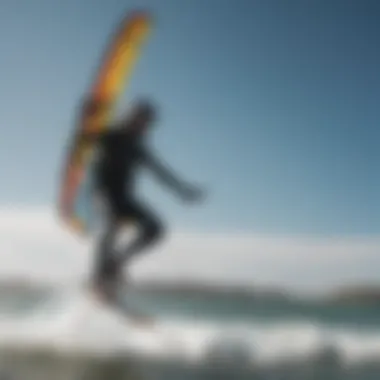

The way lift and drag interact forms the foundation of any kiteboarder’s experience, influencing not just performance, but the fun factor involved in every session on the water.
Stability and Control
Stability and control can be viewed as a kiteboarder's lifeline during their time on the water. For many, kiteboarding is about feeling secure at high speeds, and having the ability to maneuver effortlessly. The Armstrong foil package addresses these needs with thoughtful engineering and design.
Stability in a foil setup can be influenced by several factors. The length and shape of the mast contribute significantly. A longer mast generally provides more stability by allowing the foil to maintain a more consistent distance from the water's surface. However, this doesn't mean longer is inherently better—too long can introduce difficulties in control, particularly in choppy conditions or during sharp turns.
Control is about precision. It's how well the rider can manipulate the foil's position and angle relative to the water's surface. The wing design, along with the stability features of the mast and fuselage, allow kiteboarders to feel an instinctual feedback during rides—making it easier to adjust for shifts in wind or water conditions. With the Armstrong foil package, this nuanced control can make even rough days manageable and enjoyable.
In summary, understanding these performance characteristics is not only essential for optimizing one's riding experience with the Armstrong foil package but also for realizing one's potential as a kiteboarder. Recognizing how lift impacts speed and how drag interacts with those dynamics can vastly improve on-water performance. Similarly, acknowledging the aspects of stability and control hones a rider's technique, enabling them to conquer both calm days and fierce conditions with confidence.
Compatibility with Kites
When it comes to kiteboarding, having the right kite isn't just a preference—it's a primary relay in ensuring optimal performance. The Armstrong foil package, with its specific designs and engineering, interacts uniquely with various kites. Understanding this compatibility is essential, as it can elevate a kiteboarding session from mediocre to extraordinary. Here, we’ll dissect critical elements that inform why compatibility is not just a box to tick but a significant influencer of your riding experience.
One fundamental aspect of compatibility lies in how the foil interacts with the kite's pull and control. A kite designed for stability may not match well with a foil that's meant for agile maneuvering. It’s a bit like trying to fit a round peg in a square hole. Ideally, the kite should complement the foil’s characteristics. This harmony is what allows for smoother transitions and better lift. So, is it merely a matter of choosing any kite? Not quite. Each kite has distinct nuances, with size, design, and intended use all playing pivotal roles.
Here are a few key preferences to consider:
- Kite Size and Wind Conditions: Generally, larger kites catch more wind, enhancing lift but can also create excessive power for a sensitive foil. Choosing a kite size that matches the wind conditions is essential for balancing power.
- Aspect Ratio: Kites with higher aspect ratios often provide better speed and lift efficiency. Pairing them with similarly designed foils can amplify performance and agility.
- Type of Kite: Whether it’s a wave kite or a freeride kite, understanding the kind of ride you want will guide your choice towards the most effective setups.
In this vein, choosing the right kite is more than just a matter of preference—it's an investment in maneuverability and stability.
Selecting the Right Kite
Choosing a kite that works well with the Armstrong foil package can sometimes feel like navigating a maze. However, taking a methodical approach can help clarify your options.
First, consider your skill level. For beginners, it’s generally advisable to choose more stable and forgiving kites. An intermediate or advanced rider might seek kites that offer greater performance capabilities, allowing for making the most of the Armstrong foil package.
Here’s a breakdown of the most significant points:
- Riding Style: Do you favor freestyle tricks, or is it more about carving on the waves? Each riding style requires a different kite setup tailored to optimize those maneuvers.
- Wind Range: Different kites perform better in certain wind conditions. Make note of your preferred riding environments and align your choices accordingly.
- Personal Preferences: Each rider has unique preferences regarding pull and feedback from the kite. Testing various kites, if possible, can significantly aid in making an informed decision.
Also, remember that the learning curve is part of the kiteboarding journey. Experimentation may lead you to unexpected favorites, but sticking to established guidelines allows for a more straightforward experience.
Integration Challenges
While the Armstrong foil package boasts compatibility with a range of kites, challenges inevitably arise when integrating them for a seamless experience. Understanding these hurdles in advance can save time and frustration on the water.
One of the most common challenges is the tuning of the setup. Often, kiteboarding enthusiasts might find themselves adjusting lines, stoppers, and even the angles of control bars. This tuning process is crucial to ensure that the kite and foil work synergistically. Without proper adjustments, the ride can feel sluggish or even unstable.
Additionally, there’s the dilemma of different connection systems used across various brands. While the Armstrong platform strives for adaptability, not every kite will utilize the same connection system, which may lead to increased setup time or compatibility mishaps.
In terms of practicality, here are some strategies worth considering:
- Test Different Combinations: If possible, try out several kites with your foil before making a final choice. It can provide valuable insight into how they work together in real-time.
- Seek Guidance: Online forums like reddit.com or kiteboarding groups may offer personal experiences that illuminate others’ integration paths.
- Stay Informed: Keep updated on any advancements or changes in design that could affect compatibility.
Maintenance and Care
Taking proper care of your Armstrong foil package is essential for longevity and optimal performance. Just like a well-tuned engine, your gear can deliver maximum output when it’s maintained correctly. Ignoring maintenance can lead to problems that affect both performance and safety. Regular checks not only prolong the life of your equipment but also enhance your riding experience.
Routine Checks and Balancing
Routine checks are the bread and butter of kite foil maintenance. It's prudent to look over your equipment before and after each session. Key areas to focus on include:
- Wings: Check for any nicks, scratches, or delaminations that might impair lift. Even the smallest scratch can create drag and affect your speed. Ensure that the wing is free of debris.
- Mast: Inspect for bends or cracks. A compromised mast can severely affect stability and control while riding. It’s a good idea to check for any corrosion, especially if you kite in saltwater.
- Fuselage and Base Plate: Look for signs of wear where parts connect. Loose screws could make your setup not just inefficient but hazardous. Tightening these connections is a simple yet vital part of maintenance.
- Balancing: It's important to regularly check the balance of your setup. An uneven foil can lead to difficulty in handling and can affect your safety while riding. If it feels off during your sessions, take the time to readjust or reconfigure your setup.
"A well-maintained foil rides like a dream; neglect it, and you’ll find yourself wishing you had spent that extra time."
Storage Best Practices
After you've finished riding, how you store your gear is almost as crucial as how you maintain it. Proper storage can prevent wear and tear that occurs from not looking after your equipment correctly. Here are some effective storage tips:
- Drying Gear: Always ensure that the wings and mast are thoroughly dried before storing. Moisture can lead to mildew, which can be a significant issue particularly for materials used in foils. A quick towel-off can work wonders.
- Temperature Control: Keep your foil package in a stable environment. Avoid areas with extreme temperatures that might warp the materials. Keeping gear in a garage or storage box that doesn't get overly hot or cold is ideal.
- Separate Components: Try to store components separately to prevent scratches and damages. Putting your mast next to the wings can be a recipe for unintentional scuffs.
- Use a Protective Cover: Invest in a good quality cover for your foil. Not only does this protect against dust, but it can also shield against accidental knocks that can happen during storage.
Caring for the Armstrong foil package isn’t just about fixing up the gear every now and then; it's a holistic approach that safeguards your investment and ensures your kitesurfing adventures remain enjoyable. By incorporating these checks and best practices, you'll not only increase the lifespan of your equipment but also elevate your overall kiteboarding experience.
User Experiences and Insights
Diving into the world of kiteboarding, user experiences and insights stand as a critical pillar in understanding the Armstrong foil package. This aspect is not merely about personal opinions but represents a tapestry woven from the collective voices of riders who have thrived and struggled with different gear. The essence here lies in the practical application of technology in real-world scenarios. Such experiences help demystify the technical specifications, translating them into tangible benefits and potential pitfalls that future users might face.


By gathering feedback from a variety of kiteboarders—ranging from casual weekend warriors to seasoned professionals—one gets a clearer picture of how the Armstrong foil interacts with different riding styles, water conditions, and skill levels. The significance of this section lies in its ability to guide potential buyers through the maze of choices available today.
Rider testimonials often reveal key insights that specifications alone cannot convey. Understanding how riders adapt to various setups, what challenges they encounter, and, importantly, how they overcome them provides new users with realistic expectations and the knowledge to maximize their own kiteboarding experiences.
For example, a rider might share that the Armstrong foil's lift characteristics allow for smoother transitions in choppy conditions, while another might note that its responsiveness can sometimes be a double-edged sword, requiring more practice to harness its full potential.
This comprehensive analysis of real-world user experiences enriches the narrative around the Armstrong foil package, ensuring that kiteboarders are well-informed when navigating their options.
Rider Testimonials
Rider testimonials offer a direct line to the voices of those who have been on the water with the Armstrong foil package. When members of the kiteboarding community share their stories, they often illuminate features that specifications alone can’t express. For instance, consider the words of one avid rider:
"The moment I took the Armstrong foil out for a spin, I felt connected to the water in a way I hadn't before. The smooth glide really made it easier to build speed quickly, which was something I searched for in other foils."
This kind of testimonial is invaluable. It highlights not only the performance aspects, such as speed and smoothness, but also the emotional connection that enhanced gear can bring to the rider's experience.
Common themes captured in these testimonials include:
- Performance: Many riders frequently reference the agility and stability the foil provides, noting enhanced control during tricky maneuvers.
- Learning Curve: While some riders commend the responsiveness of the Armstrong foil, others emphasize a steeper learning curve compared to heavier foils, suggesting that new users might need to invest time to master this technology effectively.
- Versatility: Plenty of feedback praises the foil's ability to perform well across various wind conditions, making it a go-to choice for different environments.
These narratives speak to the importance of rider choice and adaptability, reinforcing how personal experiences shape the overall perception of the Armstrong foil package.
Comparative Analysis with Other Foils
Conducting a comparative analysis of the Armstrong foil package against other foils on the market sheds light on its unique advantages and possible drawbacks. The evaluation not only analyzes performance metrics but also considers rider preferences and variability in design and construction.
When pitted against its competitors, the Armstrong foil often shines in areas such as:
- Lift Efficiency: Riders have noted an impressive lift-to-drag ratio, often outperforming other leading brands. This characteristic allows for quicker flights and a sense of freedom that’s hard to replicate.
- Stability and Control: Compared to weightier options, the Armstrong foil tends to offer a more agile ride. However, this can result in a slightly harsher ride in turbulent water conditions, a trade-off that lighter foils often present.
- Customizability: Numerous users appreciate the modular nature of the Armstrong foil, allowing for personalized setups that suit individual riding styles better than some fixed-geometry options.
Nonetheless, ensuring an unbiased performance evaluation is crucial. Some riders have criticized the foils regarding durability in more tumultuous wind conditions, suggesting that while they excel in lighter winds, high gusts could pose challenges.
Future Innovations in Foil Technology
The realm of kiteboarding technology is in a constant state of evolution. Staying ahead of the curve is essential for both performance and enjoyment on the water. Emerging innovations in foil technology not only enhance the actual riding experience but also drive the entire discipline forward. As kiteboarding enthusiasts dig deeper into their pursuits, understanding these advancements becomes crucial. This section sheds light on both current innovations and anticipated improvements that will shape the future of kiteboarding foils.
Emerging Trends
The foil industry is buzzing with palpable energy, and several key trends are emerging that could change how riders interact with the water. One significant trend is the development of smart foils. Manufacturers are taking strides towards integrating onboard sensors and connectivity features that monitor performance metrics in real-time. These metrics could offer insights into lift, drag, and other critical aspects, allowing riders to fine-tune their setups depending on conditions.
Another noteworthy trend is the increased focus on sustainability. More brands are exploring biodegradable materials and environmentally friendly production processes. This shift not only helps in reducing the ecological footprint of kiteboarding but also appeals to newer generations of riders who prioritize environmental responsibility.
- Smart Foils: Real-time performance monitoring.
- Sustainable Materials: Eco-friendly production methods.
- Customization and Adjustability: Modular designs allowing personalized configurations.
Anticipated Enhancements
While innovations are pivotal, it's the enhancements that riders look forward to the most. Upcoming advancements are likely to center around improving aerodynamics. New wing shapes and configurations will enhance lift and reduce drag, allowing for smoother rides at varying speeds. Specific advances in computer-aided design (CAD) are facilitating this, leading to more unique foil shapes that were previously unattainable.
Moreover, the materials used in foils are set for an upgrade as well. Next-gen composite materials may be lighter, stronger, and more durable, thus providing better performance overall without the burden of extra weight. Variations in flexibility and stiffness could also be tailored more precisely, allowing riders to customize their experience according to style and preference.
"Innovation isn’t just a catchphrase; it’s the heartbeat of kiteboarding’s future, influencing each glide over the waves."
- Aerodynamics: Advancements in wing shapes for lift and speed.
- Materials: Lighter, stronger alternatives for better performance.
- Precision Engineering: Customization down to the rider's preferences.
As kiteboarders look ahead, these trends and enhancements can paint a promising picture for the future of foil technology. With these developments, riders can expect exhilarating experiences, optimized performance, and a greater connection to the natural elements.
This continuous push toward innovation ensures that kiteboarding isn't just a sport—it's a lifestyle that evolves with its passionate community.
The End
In the realm of kiteboarding, the Armstrong foil package stands out as a pivotal enhancement, revolutionizing how riders interact with the sea and wind. Understanding the intricate elements of this package not only aids enthusiasts but also informs choices that can greatly affect performance. Emphasizing performance adaptability, this package allows riders to tailor their experience, whether one seeks out the smooth glides on flat water or a more dynamic ride on choppy waves. The intelligent design of the foil components creates a balance between lift and stability – a crucial consideration for anyone venturing into this exhilarating sport.
Key Benefits:
- Performance Optimization: The Armstrong foil package's design principles allow better maneuverability and speed.
- Versatility: Riders can adapt their setup based on individual preferences and conditions, which opens the door to a wider range of experiences.
- Enhanced Learning Curve: For those new to foiling, understanding this package can lead to quicker mastery and confidence on the water.
Ultimately, the impact of the Armstrong foil package extends beyond just gear. It symbolizes a commitment to innovation in kiteboarding, setting the stage for future developments that continue to elevate the sport.
Key Takeaways
- The Armstrong foil package marries advanced technology with rider requirements, fostering an optimal experience.
- Understanding the components and their interactions is essential for peak performance and enjoyment in kiteboarding.
- Future innovations in foil technology promise to push the boundaries even further, keeping the sport fresh and exciting.
The Importance of Choice
In kiteboarding, the choices one makes can significantly shape the riding experience. The Armstrong foil package underscores the importance of selecting the right gear based on personal style and environmental conditions.
- Customizability: Riders can mix and match various elements of the package to suit their riding style.
- Experience Level: A thoughtful choice based on skill level can enhance the learning experience and build confidence on the water.
- Condition Adaptability: Understanding how different components perform in varying conditions can ensure a more fulfilling ride, whether in calm waters or rough seas.
For kiteboarders, making informed choices—particularly with an advanced system like the Armstrong foil package—opens a range of opportunities. It not only influences performance but also personal satisfaction while riding. When it comes to kiteboarding, informed choices lead to unparalleled enjoyment and adventure.







